- June Mark
- http://ltd.edc.org/people/june-mark
- Managing Project Director
- Transition to Algebra: A Habits of Mind Approach
- http://ttalgebra.edc.org/
- Education Development Center
- Mary Fries
- http://ltd.edc.org/people/mary-fries
- Curriculum/Instructional Materials Designer
- Transition to Algebra: A Habits of Mind Approach
- http://ttalgebra.edc.org/
- Education Development Center
Public Discussion
Continue the discussion of this presentation on the Multiplex. Go to Multiplex


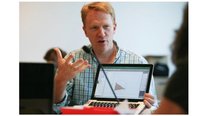
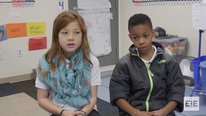
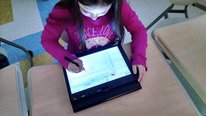
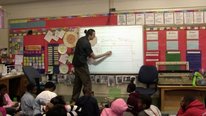
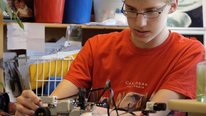
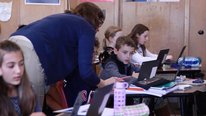
Arthur Camins
Director
June,
It looks like visual in the context of puzzles play a central role in conveying algebra ideas. Is that correct? Can you say more about that?
Thanks,
Arthur
June Mark
Managing Project Director
Hi Arthur, Yes, the visual aspect of the puzzles does play a central role in making sense of the algebra. For the mobile puzzles for example, the visual helps to make the underlying logic of systems of equations more accessible to students. Several of the puzzles in TTA leverage the use of a visual representation, and all of the puzzles aim to support students’ reasoning about the underlying logic of algebra. thanks, june
E Paul Goldenberg
Hi Arthur. We also wrote a teacher professional book /Making Sense of Algebra/ (not tied to the curriculum) that describes two roles we see for visual presentation in algebra. One is, of course, these puzzles, but the fifth chapter of that short book is titled “A Geometric Look at Algebra,” and it describes the /algebraic/ (not just arithmetic) understanding to be gained from number lines and area models. Both are used extensively in TTA. We also use a “bucket” metaphor, initially presented visually, to introduce the ideas of unknown and variable.
Elissa Milto
Director of Outreach
Hi,
In what kinds of settings have you used TTA? Is this being implemented in schools and/or informal settings? Has this been designed to be a full curriculum or is it a supplement?
Thanks,
Elissa
June Mark
Managing Project Director
Hi Elissa, TTA was designed for a full-year support course offered alongside Algebra 1 for students who are identified as underprepared for Algebra 1 in 9th grade. It’s been used in those settings but the curriculum has been picked up and used as an introduction to algebra in the middle grades, and also in some summer school settings (selected units). One advantage of using it as a full curriculum is that the development of the mathematical habits of mind is built across the year. I’m not aware of use in informal settings but I could see selected units being used in that way. Thanks for your question. — june
Sarah-Kay McDonald
Principal Research Scientist
I’d also love to learn more about the contexts in which TTA has been used, and what the project has been learning/exploring about both the short- and long-term effects of exposure to the support curriculum on mathematical habits of mind. Can you tell us a bit more about any studies that might be ongoing or have been completed on this or other student learning outcomes? Thanks!
June Mark
Managing Project Director
Hi Sarah-Kay, As I mentioned above, TTA was designed as a full-year algebra support curriculum intended to be used concurrently with Algebra 1 for underprepared students. We did conduct a pre-/post- study on student learning outcomes focusing on particular content ideas as part of the development of the curriculum. You can find a summary of our research findings at the Heinemann TTA website under Resources, http://www.heinemann.com/transitiontoalgebra/#r.... We are currently seeking funding to conduct a larger-scale study of TTA’s impacts on student outcomes, as well as teacher implementation of TTA. thanks, june
Paul Horwitz
Are the puzzles delivered on paper or on a computer, and if the latter, are they interactive and what kind of feedback or scaffolding do they provide, if any?
June Mark
Managing Project Director
Hi Paul, In the initial development of the curriculum, the puzzles were all paper and pencil. Through a different NSF grant, we were able to experiment with app-based versions of the puzzles, which can be found at http://solveme.edc.org. To date, we have released an interactive version of the mobile puzzles seen on the video. Check it out and let us know what you think. thanks, june
E Paul Goldenberg
I couldn’t resist saying hi, too. It’s fun to note that one of the things that drove us to think about the computer version is that kids were leafing through the units, doing all the puzzles, and having them all “used up” before they’d finished the work that surrounds them. That didn’t actually “ruin” the lessons, but did get us thinking that we should have a ready supply of more! The fact that the puzzles are not frills—they reflect and rehears the content /and/ the important mathematical habits of mind (a.k.a. mathematical practice)—meant that providing more of them could reasonably be expected to serve our students’ interests.
Brian Drayton
Interesting video.
I am curious about the scripts that the students read to model mathematical discourse: When are they used? Just listening to the video, I can’t quite envision how their use would be natural in the context of the problem-solving orientation of the curriculum.
June Mark
Managing Project Director
Hi Brian, Thanks for your question. The student dialogues are integrated in our lessons, and they are used to model the thinking and discussion we want to develop and encourage in students. Often, students read a dialogue after they’ve had an opportunity to work on a problem themselves. Sometimes, they are asked to extend the thinking of the students working on a problem, and other times they are asked to make sense of students’ reasoning in a dialogue. To see an example of one of our student dialogues, see page 2 at the following link: http://ttalgebra.edc.org/sites/ttalgebra.edc.or...
Also our companion teacher professional book, Making Sense of Algebra http://www.heinemann.com/products/E05301.aspx has a chapter about discussions and dialogues. Hope this helps to answer your question. thanks, june
E Paul Goldenberg
Hi Brian, You might also find it interesting to see how these dialogues are used in another context, one created as professional development for teachers but with crafted (i.e., fictional) dialogues with student voices. In a sense, there /is/ something “unnatural” about the kids’ voices in the dialogues. Nobody is to think they’re real kids. But the idea is to represent real issues that come up and model what /can/ be discussed and what a mathematical conversation /can/ look like.
Marty Gartzman
Thanks, June and Paul, for posting the video. Inspired me to finally order a set!
June Mark
Managing Project Director
Thanks for the support Marty. It’s always great to hear from you.
Gerald Kulm
You mention that students feel more like spending time with a puzzle vs a problem (or exercise?). Are there other specific behaviors that identify when a student is seeing a task as a puzzle? That is, how do I know if I am posing a puzzle or a problem to a student? Back to the old question of defining what is a math problem – problems for some are simply exercises for others. Is the same thing true of puzzles – if not, why not>
Mary Fries
Curriculum/Instructional Materials Designer
Great question! Thanks! Paul responds in detail below.
In short, “The characteristic of a puzzle is that you’re quite sure at the outset that you /can/ solve it, if you can just find some way to start.”
E Paul Goldenberg
Thanks, Mary. For some reason, I have “+ Reply” links only for a very few of the comments here, so I had to respond as if my comment were entirely spontaneous and new.
E Paul Goldenberg
Hi Gerald. We’d love to know more about this ourselves. When we use the words “problem” and “exercise,” we’re pretty clear about what we mean by the difference: an exercise is just moving the weights around, and a problem requires some thinking. Between a “problem” and a “puzzle,” the difference is, as you point out, not so crisp, and depends on how the student sees the task. That depends partly on the kid (of course) and partly on the nature of the task (of course) and partly on how “we” (curriculum and/or teacher) present it. I’m mindful of the Brown & Day (2006, I think) study of stereotype threat in which the same task (Raven’s Progressive Matrices) was presented with all the usual instructions but framed, in advance, either as an IQ test or as a set of puzzles and the outcomes were quite different. Some “problems” (e.g., Mary paints a room in 3 hours and David paints it in 5, so how long would it take if they work together?) /are/ just puzzles, with not a shred of real life validity to them, but are presented as “problems.” I guess the real difference—the behavior that identifies when a student is seeing a task as a puzzle—is the more patient-with-self, try-and-see approach. I’m supposed to be able to solve problems, and if I can’t, um, maybe I’m not so good. I’m supposed to be puzzled by puzzles—that’s what makes them puzzles—so if I’m puzzled, well, fine, I can just figure it out. /NOT/ everyone likes puzzles, but enough people do to keep supermarkets (not just high-end bookstores for geeks) selling them. The characteristic of a puzzle is that you’re quite sure at the outset that you /can/ solve it, if you can just find some way to start. That’s how we’d like our students to handle all of the work they’re doing, and one of the (several) reasons why we like infiltrating puzzles throughout, making them not a dessert but a part of the main course. Ideally, I’d love teaching to treat even the non-puzzliest routine stuff with a bit less existential weight than we sometimes see. For a particularly mundane example, confusing 7×8 with 6×9 is /so/ routine an error that it can be treated as funny rather than tragic /even/ if we really care that the kid sort it out sooner rather than later. And the lighter touch might actually speed the sorting out!
Pardon the slight digression. I think it’s only slight! :-)
Arthur Camins
Director
Your presentation indicated that your materials were used as a supplement the regular algebra course. Who teaches each? Is there coordination of approaches? How has that worked out?
E Paul Goldenberg
Ah, yes. The question! :-) That has varied a whole lot. While we were doing the development and field tests (prepublication), one school had a “math lab” that was neither contiguous with the algebra class nor taught by the students’ algebra teachers, /nor/ were the teachers who taught TTA necessarily teaching /any/ algebra class that year. And no explicit coordination (though teachers knew each other, of course, and sometimes talked informally). In another school, all the TTA classes were conducted during the last block of the day, and all of them by the algebra faculty, but students did not necessarily have the /same/ teacher for TTA as for algebra. In one middle school that is using TTA to launch kids into algebra early (including their weakest students), it is not a parallel course, but a component of the one mathematics course the students receive during the year. All that I can easily say about how it “works out” is that I have to believe (gut dictating belief!) that coordination would bring more benefits, but lacking that coordination doesn’t seem to have worked mischief. We heard a few times Algebra Class teachers expressing pleasant surprise when their “at-risk” students (the ones in TTA) found polynomial multiplication particularly easy (partly because our visual area model helps them, but possibly also because they’d actually encountered it in TTA /before/ they reached it in Algebra class, so they were ahead of the game). It /could/ be (but understand, please, that I’m making this up!) that the surprise for the algebra teacher turned into a boon for the kids by raising their impressions of what the kids could do, a benefit on top of the actual logical learning that the kids got from TTA. We don’t know, though. The implementations varied, as did the amount of information we were able to track in each school.
Sybilla Beckmann
I love this puzzle idea! Is there something about a puzzle that seems more like an invitation to stretch your thinking rather than a requirement to find an answer? Could that sense of puzzle — invitation rather than requirement — make a difference for students? Or is there a difference in the very type of activity in a puzzle versus a problem? Or is it a bit of both?
June Mark
Managing Project Director
Hi Sybilla, Sometimes what is attractive about a puzzle is that there’s not the expectation that there is one answer but for example in a Sudoku puzzle you need to find a starting point, figure out some information, and use that information to help you progress in making sense of other parts of the puzzle. We want students to use these same dispositions to solve mathematical puzzles, and in the curriculum, we try to pose problems/puzzles worthy of that kind of reasoning and strategic thinking. We also want students to bring these kinds of habits to solving more typical mathematical problems as well as puzzles. thanks, june
Further posting is closed as the showcase has ended.